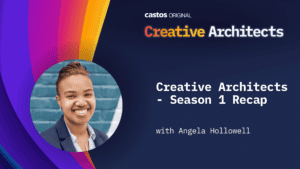One of the biggest players in the podcasting industry is Apple Podcasts. Up to this point, they have helped dictate major shifts in podcast consumption and how podcasters create their shows.
Given Apple Podcasts’ popularity, it’s no surprise getting in front of their curation team can help propel a podcast to new heights. But the question is, how can I pitch my podcast to appeal to their editors?
This week on Audience, we’re tackling this important topic with Bobby Temps. As the co-host of Mental: The Podcast to Destigmatise Mental Health, he has orchestrated getting his show on multiple featured podcast lists inside the popular listening app. Throughout our interview, Bobby sheds light on repeatable strategies that helped him break through the noise and impress the Apple Podcasts team.
But that’s not all we’re covering. At the top, we get into how the Mental podcast encourages listener participation, uses data to inform their content decisions, and why you might be missing some reviews from your international listeners.
Listen to the full interview now to starting pitching you podcast with more flair and to track down those reviews you may have missed.
How has COVID-19 changed your listenership?
Like many other podcasters, Bobby and his co-host, Danielle, have shifted their content strategy as a result of COVID-19. But since the show focuses on mental health, they’ve noticed the shift has primarily been driven by changes in society.
The goal of the podcast is to destigmatise mental health. So Bobby and his team are capitalizing on our eagerness to include mental illness alongside physical ailments in the wellness conversation. To alter content for these times, they’ve focused on practical tips listeners can put to use right now. Their mission is to help both loyal and new followers feel more confident and secure in times that are unstable.
How Do You Encourage & Incorporate Audience Participation Into The Show?
Let’s start with the motivation factor. Every podcaster wants more reviews and emails with feedback from their audience. But it’s difficult to help listeners take the next step and put pen to paper.
To help, Bobby highlighted the tone of the Mental podcast. His team has ramped up the calls-to-action to leave a review or send a email. But they positioned their messaging around the desire to tackle subjects their audience needs help with right now. The authenticity of wanting to provide their listeners with timely tips didn’t go unnoticed. They received more feedback and were able to cover topics that were important to their community.
In times before COVID-19, the Mental podcast is one of the best examples of why audience participation can make or break a show. The podcast covers the rapidly changing landscape of mental health and typically sensitive subjects. Their team understands the need to use appropriate language and phrases for each topic, but the standards shift.
For example, the phrase “committing suicide” is no longer the most appropriate way to talk about this topic. Through conversations with their community and mental health experts, the Mental podcast team were made aware of the sensitivities and have changed the way they speak about death by suicide.
In addition, using audience feedback and interviews allows Bobby to include more experiences about the same topic. Even if he has experience with an issue they discuss on the show, they’re cognizant about the fact that it doesn’t mean he can talk about everybody’s experience. In having the community chime in with their thoughts, they’re able to cover the more mental health topics in more detail.
Do You Have Any Tips To Better Prepare For An Interview?
Bobby takes a person-centered approach and if you think about other great interviewers, they all do too. The person-centered approach has the host view themselves as the facilitator for the guest to share their story. The focus is on how the host can do the best job at creating a safe space.
While an interview is a more structured conversation, it’s still a conversation first. In the research phase, Bobby tries to find the balance of being knowledgable about the story but not over researching. You may be scratching your head but think about it from the listener’s perspective.
His guests are often telling surprising and emotion-filled stories. If Bobby knows every twist and turn, when the story reaches its climax he has to feign surprise. As a listener, it’s obvious when someone already knows the punchline. But by allowing the guest to tell him these details live on air, he’s finding out the information at the same time as the audience. The listener realizes they’re having the same reaction as Bobby and he then asks the follow up questions that are likely on their mind. These elements of surprise and authentic emotion amp up the listener’s experience and makes them feel part of the show.
During the interview, Bobby employs another person-centered strategy called mirroring. Here he uses the same language as the guest to repeat their story back to them, but in his words and from his point of view. Not only does it help the interview keep its pace, but it signals to the guest that he’s listening which helps create their safe space. For guests who aren’t seasoned public speakers, there’s an added benefit. When they hear their story repeated back, it can help trigger a realization and cause them to elaborate more. In these elaborations, they often have real-time epiphanies where they’re figuring out something live on the show. These moments are beloved by the Mental podcast community and is one reason they love to tune in.
The last tip helps to keep listeners engaged during the interview. For guests, it’s easy to forget that podcasts are audio only. You miss the visual cues and aides that help public speakers get their point across. To combat this, it’s the host’s job to translate hand gestures or body language to make listeners feel like they’re included in the conversation. Also, try addressing your audience by name. Call outs like “this is something I want to repeat for our listeners” is a great way to call attention the information that will help them grasp the topic.
How Can I Get My Show Featured On Apple Podcasts?
Mental has been featured across numerous Apple Podcasts curated lists and noteworthy sections. But it wasn’t an accident, it was by design.
As the show began to grow organically and the team refined each episode, Bobby started regularly pitching Apple Podcasts. His pitch described the show and why it was worthy of being included in their highly sought after featured lists. And it worked. Mental has been included in a COVID-19 Essential Listening roundup and multiple mental health must-listen lists.
So how can you repeat Bobby’s strategy for your own podcast? Here’s what to consider to be featured on Apple Podcasts.
How to pitch Apple Podcasts
The best way to pitch a podcast to Apple’s editorial team is via their Podcast Promotion Request form.
Tailor your pitch to what the Apple Podcasts’ team is looking for in addition to explaining why your show is great. Tactics that have worked for Bobby include:
- Mentioning your guest interviews on other podcasts that Apple has featured in the past
- Highlighting upcoming content angles that match consumer listening trends
- Detailing why your podcast is a peer to the other shows Apple has recommended in your niche
- Mentioning your podcast’s ranking in your niche if it’s a competitive position
- Talking about how you promote your Apple Podcasts’ subscribe links to your community (remember, Apple Podcasts is interested in featuring great content but they’re also looking for more users too)
- Including links to any other roundups your show appears in to offer social proof that your podcast is noteworthy
Apple Podcasts’ main carousel & category recommendations
Apple Podcasts has two main curated lists to recommend interesting podcasts. It’s important to recognize the differences so you can craft the best pitch possible.
The first option is being featured in the front page carousel. When users log into the app, this is the first screen they’ll see. Due to the prime real estate, this is a tougher spot to snag. Bobby suggests two tactics for this main carousel based on his insider knowledge.
Tip number one is to focus on more timely content. The Apple team is looking for episodes and shows that talk about specific trends that people are talking about in any given week. For example, as Pride month approaches they include roundups of the best LBGTQ+ content out there. If your podcast touches this niche, it’s best to send your pitch in May to align with Pride month in June.
Tip number 2 is to consider global trends. A lesser known fact is Apple Podcasts’ featured lists are country specific. You’ll need to pitch their UK and US editors to be featured in each location. Capitalize on an international trend to gain followers from outside of the United States.
The second option is being featured in category specific recommendations. This is the easier spot to secure because you’re competing with a smaller subset of shows. Also, editors add new additions to their lists on an ad-hoc basis. Since you aren’t pigeon-holed to timely trends, you can submit this pitch at any time. But it still needs to have all the key elements mentioned above to stand out from the pack.
Bobby also recommends leaning into showing why your podcast is relevant to the other shows in your category. This is why choosing the right podcast categories is an important decision.
Am I Missing Some Of My Podcast’s Reviews?
Did you know Apple Podcasts sorts listener reviews by country? When you view your listing from the United States, you’re only seeing US based reviews. But if you log in from London, the review section will update to UK based reviews.
With asking listeners to leave a review, you might have missed your international follower’s kind words. If you have a global audience or want to build one, remember these tips:
Chartable not only lets you keep an eye on your podcast’s rankings. It also pulls together all of your recent reviews into one place. You can use their dashboard as a one stop shop to analyze your show’s performance and global reviews.
If you don’t want to pay for Chartable’s services, there’s a way to do it for free. On a desktop, got to your show’s listing on Apple Podcasts using any browser. The URL will look like https://podcasts.apple.com/us/podcast/audience/id1491047450 (this is Audience’s listing). Notice the /us/ right in the middle of the link. That’s the country code that automatically populates depending on where you’re located.
To see your listing in another country, simply change that country code. For example, to view Audience as a UK based user, the link would be https://podcasts.apple.com/gb/podcast/audience/id1491047450. Noticed we included /gb/ instead of /us/. When we compare the review section, our US listing has 7 reviews and our UK version has 2.
After working so hard to motivate your listeners to leave a review, make sure to do the due diligence on your side to read them all.
Resources Mentioned In This Episode
- Subscribe to Mental: The Podcast to Destigmatise Mental Health
- Fill out Apple Podcasts Promotion Request form to pitch your podcast (Read more about their submission guidelines here)
- Check out Chartable
- Subscribe to Audience



